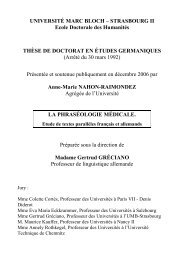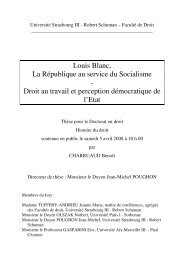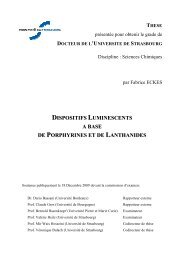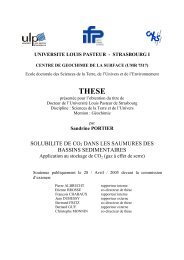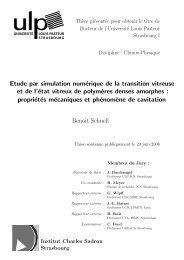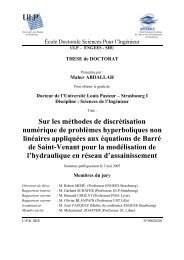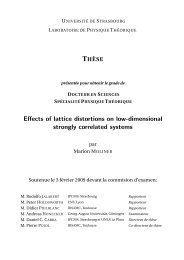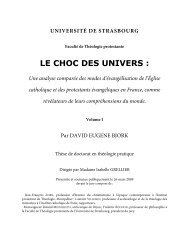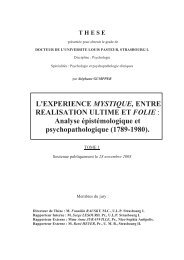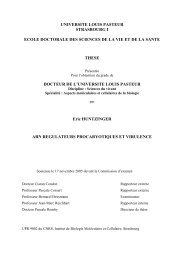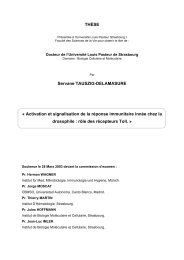Anthony KERMAGORET - THESES ET MEMOIRES DE L'UDS
Anthony KERMAGORET - THESES ET MEMOIRES DE L'UDS
Anthony KERMAGORET - THESES ET MEMOIRES DE L'UDS
You also want an ePaper? Increase the reach of your titles
YUMPU automatically turns print PDFs into web optimized ePapers that Google loves.
Chapitre I<br />
these conditions, precatalyst 16 showed a higher activity but a lower selectivity in C4 products<br />
and 1-butene than 13-15.<br />
A comparison between the four different functions available in the complexing arm<br />
shows that with both cocatalysts, the tertiary amine (precatalyst 13), the secondary amine<br />
(precatalyst 14) and the ether function (precatalyst 15) led to similar catalytic results in<br />
ethylene oligomerization but the morpholine function (precatalyst 16) led to a less active<br />
catalyst with AlEtCl2 but a more active catalyst with MAO.<br />
(ii) Influence of the Ligand Coordinating Arm. In contrast to 4, complexes 13-17 have a<br />
coordinating arm which could display either static chelation or potentialy hemilabile behavior<br />
and therefeore influence the catalytic results. A comparison of the results obtained with 4 and<br />
13-16, in which the nickel center is coordinated by two ligands, is provided in Table 3. The<br />
activity of 4 (28500 and 45000 mol C2H4/mol Ni⋅h with 6 and 10 equiv of AlEtCl2,<br />
respectively) and its selectivity for 1-butene were higher (14%) than those of 13-16. However<br />
the selectivity for C4 olefins was only 51% with 4 but up to 90% with 13-16. This suggests<br />
that the presence of the coordinating arm in the 18 electron complexes 13-16 disfavors both<br />
the insertion of ethylene and the reinsertion mechanism which leads to the C6 oligomers (see<br />
below).<br />
(iii) Influence of the Coordination Geometry of the Metal. One of the objectives of the study<br />
was to determine the influence on the catalytic properties of hexacoordination in complexes<br />
with two tridentate benzoquinonemonoimine ligands and of pentacoordination in complexes<br />
containing only one benzoquinonemonoimine ligand and two chlorides. This can be done by<br />
comparing the performances of compounds 13 and 17. Precatalyst 17 led to higher activities<br />
than 13 with AlEtCl2 or MAO as cocatalyst, up to 48200 mol C2H4/mol Ni⋅h with AlEtCl2 and<br />
20300 mol C2H4/mol Ni⋅h with MAO (Table 4). In the presence of MAO or AlEtCl2, the most<br />
active precatalyst in the series was 17. The difference of activity between 17 and 13 could be<br />
due to an easier generation of the active species by nickel alkylation in the former case than<br />
with 13 where it probably requires the loss of a chelating N,O ligand. However, its selectivity<br />
for C4 products and for 1-butene was lower than with 13.<br />
The catalyst ability to reinsert the primary C4 products has a clear impact on product<br />
selectivity (Schemes 4 and 5). Data in Table 5 show that the fraction of branched C6<br />
oligomers formed from 2-butene was ca. 60% for 17 and ca. 53% for 13 with AlEtCl2. A<br />
similar observation was made with MAO as cocatalyst. Consequently, precatalyst 17, which<br />
15



